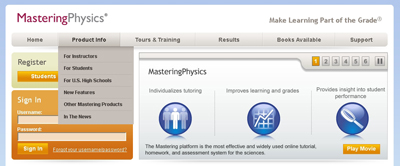Using PSI (The Personalized System of Instruction) for Active Learning
The Personalized System of Instruction (PSI) is a system that helps learners take control of and manage their own learning. Students set their own learning goals, manage their learning, and communicate with others in the process of learning.

Screenshot of Mastering Physics’ website
Fred. S. Keller together with J. Gilmour Sherman, perfected the PSI method (also known as the Keller Plan) in the late 60s. In the 1970s and 1980s, PSI spread to other disciplines and to other universities, but by the mid 80s, fell out of favour and totally died out in Physics. A key component of PSI was that there had to be an instant response to students in order to permit them to advance independently. The teacher, the proctors, the assistants would have to be writing, preparing and administering tests and then correcting them rapidly. Without computers, it was just too much work for everybody involved.
PSI and Mastering Physics
In the Winter of 2005, I was called upon to teach Mechanics to the first student cohort of the newly established Arts and Science program at Marianopolis College. I had reviewed the textbook by Randle D. Knight. It supports physics education research and active learning. But what caught my interest the most was the sealed leaflet that came with the book and contained an access code to “MasteringPhysics”.

Screenshot of Mastering Physics’ website
Mastering Physics is a powerful online platform that is linked to several textbooks and that includes self-correcting assignments or tests. Because this online system, where students are able to do self-correcting problems, provides instant feedback, I am now able to incorporate PSI into my class. The self-correcting tests become mastery tests which provide instant feedback to students so they know exactly how they are doing. Once they take a mastery test and get a grade of at least 80% they can move from one unit of work (a chapter) to the next unit. A very good grade demonstrates mastery.
Class activity can vary according to the students’ mastery of the material, which is why we call it a Personalized System of Instruction. I will give a lecture for example on circular motion, and also that week I will have a collaborative session for students to work in groups covering the same topic. This is part of the mastering; they’re learning. Now what could be happening is that some students master certain information more slowly than others, so they need extra help. That’s why I’m there and perhaps there is a student assistant who will also help out during the collaborative work.
Students who have gotten ahead can come to class and help out other students or not. What will probably happen is that using MIO on the Omnivox System, they will ask to take the mastery test on circular motion because they have already mastered it. I send them the link to the test and once they have proved their mastery, they will start on the next unit. Other students, who have not yet mastered the topic, will come to class and work with the collaborative group.
PSI and Grading
As important as they are, the mastery tests are nothing more than an assignment mark. I want the students to work on their own, at home or at the library – wherever they are. And, I told them that the importance of the mastery test is to see if they have mastered the material. If they copy that won’t help them, because the assignment mark is 5%, a small fraction of the total grade.
The principal means of evaluation comes from two supervised term tests and a final exam. Students know all this in advance, and although they’re working at their own pace, they know that, for example, on a given date Test number 1 will cover Chapters 1 to 5. The tests can be worth twenty percent of the total grade or they can be worth forty percent of the total grade depending on which scheme provides the students with a higher final grade taking the results of the final exam into account.
PSI – Actively Engaging Students
Let me fast forward to the present. The Reform stresses learning outcomes and emphasizes the process leading to learning outcomes. It also promotes integration of learning and fosters the development of more complex intellectual problem solving skills (MELS. 2005). In fact, it has been suggested :
That when PSI is implemented correctly, it produces higher levels of achievement among students than the lecture-discussion format. Hence, PSI students may be more likely to develop the necessary knowledge base and problem-solving strategies. Research has demonstrated that students enrolled in PSI improved higher order cognitive skills. (Reboy, al. 1991)
PSI is an “instructional delivery system” and as such would not dictate course content. A competency-based structure would be easily accommodated by PSI. Also, the integration of several subjects can be easily made (e.g. Physics and Mathematics) through appropriate modules. To top it all, we would have extensive integration with technology as all of the modules and tests would be computer-based and online (Pear, Crone-Todd. 2002). Computer-based instruction makes for a more active learning experience by allowing students to receive ongoing feedback and evaluation of course content.
A modernized PSI for science instruction would establish a dynamic, student-centered, active learning teaching environment with well-defined learning objectives, activities and assessments. It would move the traditional classroom to one that is student-in-charge (Active Learning).
Numerous teaching methods, based on educational research, have demonstrated that greater student involvement in the classroom enhances learning. This research has demonstrated that students learn more if they are actively engaged with the material they are studying.
(Paulson, Faust. 1998)
How are you integrating third-party online learning platforms into your teaching?

